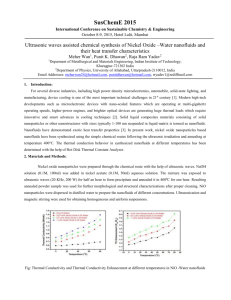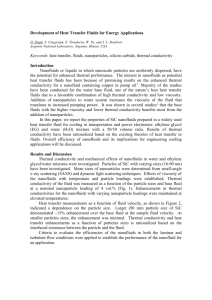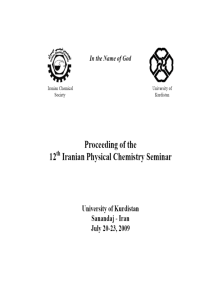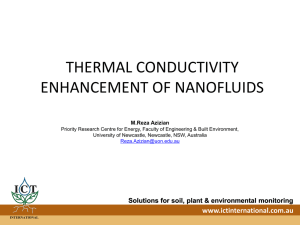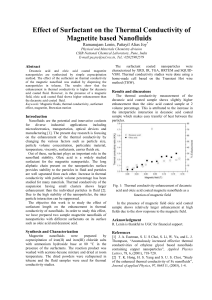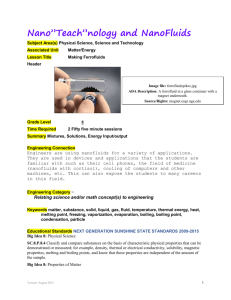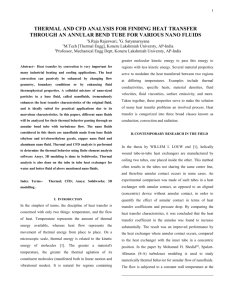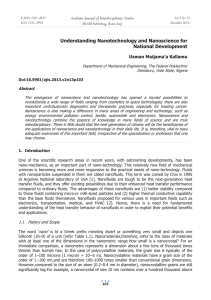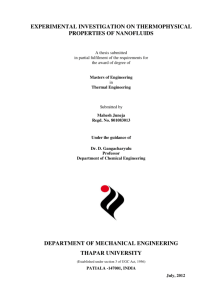26bis - INNOVATIVE DESIGN FOR COOLING SYSTEM
advertisement
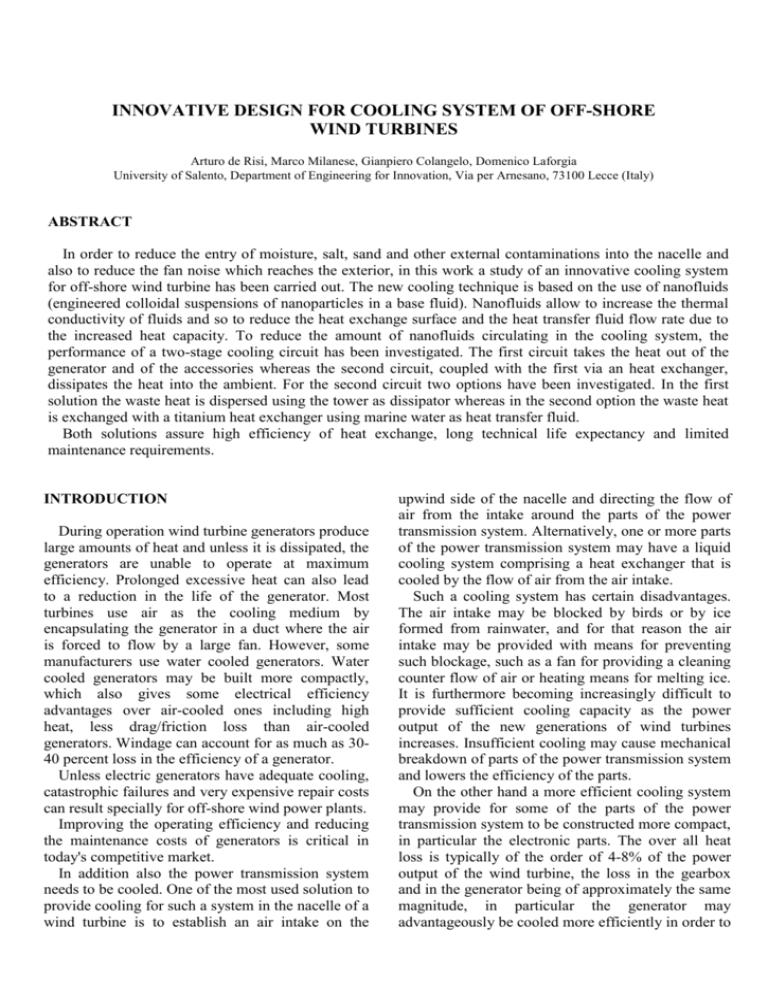
INNOVATIVE DESIGN FOR COOLING SYSTEM OF OFF-SHORE WIND TURBINES Arturo de Risi, Marco Milanese, Gianpiero Colangelo, Domenico Laforgia University of Salento, Department of Engineering for Innovation, Via per Arnesano, 73100 Lecce (Italy) ABSTRACT In order to reduce the entry of moisture, salt, sand and other external contaminations into the nacelle and also to reduce the fan noise which reaches the exterior, in this work a study of an innovative cooling system for off-shore wind turbine has been carried out. The new cooling technique is based on the use of nanofluids (engineered colloidal suspensions of nanoparticles in a base fluid). Nanofluids allow to increase the thermal conductivity of fluids and so to reduce the heat exchange surface and the heat transfer fluid flow rate due to the increased heat capacity. To reduce the amount of nanofluids circulating in the cooling system, the performance of a two-stage cooling circuit has been investigated. The first circuit takes the heat out of the generator and of the accessories whereas the second circuit, coupled with the first via an heat exchanger, dissipates the heat into the ambient. For the second circuit two options have been investigated. In the first solution the waste heat is dispersed using the tower as dissipator whereas in the second option the waste heat is exchanged with a titanium heat exchanger using marine water as heat transfer fluid. Both solutions assure high efficiency of heat exchange, long technical life expectancy and limited maintenance requirements. INTRODUCTION During operation wind turbine generators produce large amounts of heat and unless it is dissipated, the generators are unable to operate at maximum efficiency. Prolonged excessive heat can also lead to a reduction in the life of the generator. Most turbines use air as the cooling medium by encapsulating the generator in a duct where the air is forced to flow by a large fan. However, some manufacturers use water cooled generators. Water cooled generators may be built more compactly, which also gives some electrical efficiency advantages over air-cooled ones including high heat, less drag/friction loss than air-cooled generators. Windage can account for as much as 3040 percent loss in the efficiency of a generator. Unless electric generators have adequate cooling, catastrophic failures and very expensive repair costs can result specially for off-shore wind power plants. Improving the operating efficiency and reducing the maintenance costs of generators is critical in today's competitive market. In addition also the power transmission system needs to be cooled. One of the most used solution to provide cooling for such a system in the nacelle of a wind turbine is to establish an air intake on the upwind side of the nacelle and directing the flow of air from the intake around the parts of the power transmission system. Alternatively, one or more parts of the power transmission system may have a liquid cooling system comprising a heat exchanger that is cooled by the flow of air from the air intake. Such a cooling system has certain disadvantages. The air intake may be blocked by birds or by ice formed from rainwater, and for that reason the air intake may be provided with means for preventing such blockage, such as a fan for providing a cleaning counter flow of air or heating means for melting ice. It is furthermore becoming increasingly difficult to provide sufficient cooling capacity as the power output of the new generations of wind turbines increases. Insufficient cooling may cause mechanical breakdown of parts of the power transmission system and lowers the efficiency of the parts. On the other hand a more efficient cooling system may provide for some of the parts of the power transmission system to be constructed more compact, in particular the electronic parts. The over all heat loss is typically of the order of 4-8% of the power output of the wind turbine, the loss in the gearbox and in the generator being of approximately the same magnitude, in particular the generator may advantageously be cooled more efficiently in order to prevent break-down of the generator and both the rotor and the stator of the generator may be cooled. Furthermore, the power control system and the electrical transformer, e.g. comprising a frequency converter, may also constitute a part of the power transmission system and may also be cooled to obtain better efficiency. A possible solution for increasing the performance of water-cooled systems is to use nanofluids. Nanofluids are engineered colloidal suspensions of nanoparticles (1-100 nm) in a base fluid. Common base fluids include water, organic or metal liquids. Nanoparticles are typically made of chemically stable metals, metal oxides or carbon in various forms. The size of the nanoparticles imparts some unique characteristics to these fluids, including greatly enhanced energy, momentum and mass transfer, as well as reduced tendency for sedimentation and erosion of the containing surfaces. Solid particles have a higher conductive heat transfer coefficient than liquids. Nanoparticles are added because they stay suspended much longer than larger particles and their surface area (referred to the volume) is 1000 times larger than that of microparticles. The smaller the particles’ size is the higher their capacity of heat transfer enhancing. Nanofluids are being investigated for numerous applications, including cooling, manufacturing, chemical and pharmaceutical processes, medical treatments, cosmetics, etc. The idea of increasing heat conductivity in fluids by suspending high conductive particles in a liquid was first proposed by Maxwell in 1881 in his “A Treatise on Electricity and Magnetism” [1]. In the first studies millimeter or micrometer particles sized were used, but, although revealed some enhancement, their dimensions caused quick sedimentations, abrasions and clogging [3, 4]. The first studies revealed an increase in thermal conductivity of 20% for 4%vol CuO nanoparticles with average diameter 35 nm dispersed in ethylene glycol. A similar behavior has been observed with Al2O3 nanoparticles and better results might be obtained by using Cu nanoparticles or Carbon Nanotube (CNT) [5, 6]. The reduced dimensions of the particles used in nanofluids have many advantages against bigger particles. Such enhancement depends on many factors such as the particles shape, dimensions, volume fractions and the materials thermal properties. Each solid particle is surrounded with a liquid layer having better conductive characteristics than remaining base liquid [7]. Besides, there is a nanoconvection motion phenomenon near nanoparticle [8]. Therefore, in the present investigation the possibility to use nanofluids based cooling system combined with innovative solutions for dissipating the waste heat has been studied. NANOFLUID CHARACTERIZATION In order to acquire significant data on the thermal properties of nanofluids mixtures of base fluid with different commercially available nanoparticles have been tested. The used nanoparticles are reported in Table 1. Table 1: Powders used in the nanofluids samples Material Codex CuO E Effective density (kg/m3) 6.50 Al2O3 B 3.97 ZnO M 5.60 Mean size (nm) 19.29 (SMD) 22.91 (SMD) 70 (leq) Thermal Conductivity (W/m K) 20.0 25.1 29.0 Liquid phases used in the nanofluids samples is demineralised water with non ionic dispersant, to stabilize the suspension. The nanofluids thermal conductivity was measured through an instrument based on hot-wire technology which is a standard method to measure thermal conductivity of non-metallic liquids according to the standard ASTM D 2717 – 95 [9]. The experimental apparatus is made by a short platinum wire welded on the support and immersed in a cylindrical cell where the nanofluid sample is placed. Besides, a thermocouple measures the average temperature in the measuring cell. Border effects on the wire are negligible and thermal conductivity value is not dependent on eccentricity between wire and internal surface cell, as demonstrated by equation (1). d T q d ln t 4k (1) Where T [°C] is the difference between fluid temperature and a reference temperature, k [W/m K] is fluid thermal conductivity, q [W/m] is heat flux and t [s] is the time. In the apparatus used in this work, a platinum wire (with diameter of 0.1 mm and length of 35 mm) and a thermocouples are connected with an electronic device that allows the simultaneous determination of the thermal conductivity and the average temperature. Reproducibility is ±1%. To assure a perfect mixing between the nanoparticles and the base fluid both liquid and solid phases, were mixed for 60 minutes with magnetic homogenizator. The suspension then was shacked in an ultrasonic vibrator to break clusters of nanoparticles. The solid volume fractions in these samples were 1.0%, 2.0% and 3.0% and the only temperature investigated was 20°C. H2O TS identifies thermal conductivity of the base fluid (water with no powders inside). Figure 1, Figure 2 and Figure 3 show experimental data. The results obtained with these samples were in accordance with those presented in literature [1, 2, 8]. As expected thermal conductivity is directly proportional to volume fraction and best results have been obtained with ZnO nanoparticles. Figure 3: Experimental data for nanofluids with water and dispersant and ZnO COOLING SYSTEM CONFIGURATION In the present investigation two cooling system options have been considered and each solution is characterized by two steps, as Figure 4 and Figure 5 show. Figure 1: Experimental data for nanofluids with water and dispersant and Al2O3 Figure 4: Cooling system configuration (option 1) Figure 2: Experimental data for nanofluids with water and dispersant and CuO wind turbine and typical dimensions are reported in Table 2. Table 2: Wind turbine characteristics Maximum tower diameter 4,15 m Minimum tower diameter 2,3 m Tower height 80 m In the option 1, to simulate the overall performance of the cooling system a 0D model has been built. Heat transfer from the tower to the ambient has been modelled according to the theory of external flow normal to the axis of a circular cylinder. According to this theory the local Nusselt number varies with the nature of the boundary layer development on the surface and therefore is a function of the angular position , defined as in Figure 4. Figure 5: Cooling system configuration (option 2) The first heat exchanger placed inside the nacelle of the wind turbine is the same for both the two configurations described. It is conceived to work with nanofluid as heat transfer fluid. This solution can assure good heat extraction from the electric and electronic part preventing overheating in a better way than traditional fluids because nanofluids are capable to enhance the heat transfer per unit of area, that is the weak point of the electric devices that produce a big amount of thermal power in a small area. The enhancement of heat transfer from the electric and electronic devices can be a very important goal to assure long technical life and less maintenance costs. In the first option (Figure 4) the waste heat is dissipated through the tower. To obtain this result the internal side of the tower should be welded to a spiral pipe with a step of 10 cm and an internal diameter of 2 inch. In this way the wind tower can be used as a heat dissipater. The second option considers the possibility to dissipate the waste heat directly in the sea, using a titanium heat exchanger in order to minimize the maintenance costs. Both options were referred to a typical to 2/3 MW Figure 4: Boundary layer formation and separation on a circular cylinder in cross-flow. Correlations may be obtained for the local Nusselt number, and at the forward stagnation point for Pr>0.6, boundary layer analysis yields an expression of the form: NuD 0 1.15 Re1D/ 2 Pr1/ 3 (2) However from the standpoint of the engineering calculation carried out in the present investigation the empirical correlation due to Hilpert and reported next as equation (3) was used. Nu hD C Re mD Pr1/ 3 k (3) Where C and m are constant that for ReD number greater than 106 are equal to 0.076 and 0.7, respectively. It is important to notice that the above correlation is reasonable only for high values of the Reynolds number (ReD >106). To simplify the calculations each spire of the tower heat exchanger has been considered separately with its boundary conditions linked to the previous and following one. In particular the inlet water temperature is the outlet water temperature of the previous spire. In this way it is possible to approximate the heat flux along the spire surface as a constant and to have a good approximation in the results. Three cases have been investigated to evaluate the portion of the tower that must be employed to assure a proper heat dissipation at different external air temperatures, as Table 3 shows. Table 3: Case under investigation Case 1 Case 2 Case 3 Air velocity (m/s) 14 14 14 Air temperature (°C) 20 30 40 Calculations have been carried out considering that the typical waste thermal power for a 2 MW wind turbine is around 100 kW and thus the heat exchanger has been designed to dissipate this thermal power. Figure 6 shows the results obtained for the 3 cases considered: the minimum height of the tower heat exchanger has been calculated in function of the inlet temperature of the heat transfer fluid, from a minimum of 60 °C to a maximum of 90 °C. In particular in the figure each curve is referred to a different external air temperature. Height of the exchanging tower [m] 45 40 External air temperature 20 °C 35 External air temperature 30 °C 30 External air temperature 40 °C 25 20 tower should be equal to 15 m, instead with 40 °C for external temperature and 50 °C for heat transfer fluid this value rises up to 40 m. Both these results are compatible with the wind tower height, that is 80 m. In the second option (Figure 6) the tower heat exchanger is substituted by a closed hydraulic circuit that exchanges thermal power with the sea through an additional titanium heat exchanger. This solution is more simple than the first one, but can yield more problems because of the use of sea water as heat transfer fluid. CONCLUSIONS In this work different cooling solutions for offshore wind turbines have been analyzed. In particular the proposed options use nanofluids to enhance the performance of the heat exchanging devices, to assure long technical life and low maintenance cost for the electric and electronic parts of the turbine. The first results show that both the solutions are very promising and need of further investigations to setup the final configuration and to start numerical and experimental campaign to test the proposed solutions. REFERENCES [1] Q. Xue, Wen – Mei Xu, A model of thermal conductivity of nanoflujids with interfacial shell, Materials Chemistry and Physics 90 (2005), pp. 298 – 301. [2] Yimin Xuan, Qiang Li, Heat transfer enhancement of nanofluids, International Journal of Heat and Fluid Flow 21 (2000), pp. 58 – 64. [3] Yurong He, Yi Jin, Haisheng Chen, Yulong Ding, Daqiang Cang, Hulin Lu, Heat Transfer and flow behaviour of aqueous suspensions of TiO2 nanoparticles (nanofluids) flowing upward through a vertical pipe, International Journal of Heat and Mass Transfer 50 (2007), pp. 2272 – 2281. 15 [4] A.G. Agwu Nnanna, Experimental Model of Temperature – Driven Nanofluid, Journal Heat Transfer – June 2007 – Volume 129, pp. 697 – 704. 10 5 0 50 60 70 80 90 Temperature of heat transfer fluid [°C] Figure 6: Height of the exchanging tower for 3 cases. Considering the highest temperatures: 40 °C for external air and 90 °C for heat transfer fluid it is evident that the minimum height of the exchanging [5] Qing – Zhong Xue, Model for effective thermal conductivity of nanofluids, Physics Letter A 307 (2003), pp. 313 – 317. [6] Y. Hwang, J.K. Lee, C.H. Lee, Y.M. Jung, S.I. Cheong, C.G. Lee, B.C. Ku, S.P. Jang, Stability and Thermal conductivity characteristic of nanofluids, Thermochimica Acta 455 (2007), pp. 70 – 74. [7] P. Keblinski, S.R. Phillpot, S.U.S. Choi, J.A. Eastman, Mechanism of heat flow in suspensions of nano-sized particles (nanofluids), International Journal of Heat and Mass Transfer 45 (2002), pp. 855 – 863. [8] Seok Pil Jang, Stephen U.S. Choi, Effect of parameters on nanofluids thermal conductivity, Journal Heat Transfer – May 2007 – Volume 129, pp. 617 – 623. [9] ASTM D 2717 – 95, Standard Test Method for Thermal Conductivity of Liquids. [10] Alessandro Franco, An apparatus for the routine measurement of thermal conductivity of materials for building application based on a hot – wire method, Applied Thermal Energy 27 (2007) pp. 2495 – 2504. [11] Kau – Fui Vincent Wong and Tarun Kurma, Tranport properties of alumina nanofluids, Nanotechnology 19 (2008) 345702, (8 pp.). [12] J. Buongiorno, Convective transport in nanofluids, Journal Heat Transfer – March 2006 – Volume 128, issue3, 240 (11 pp.).
